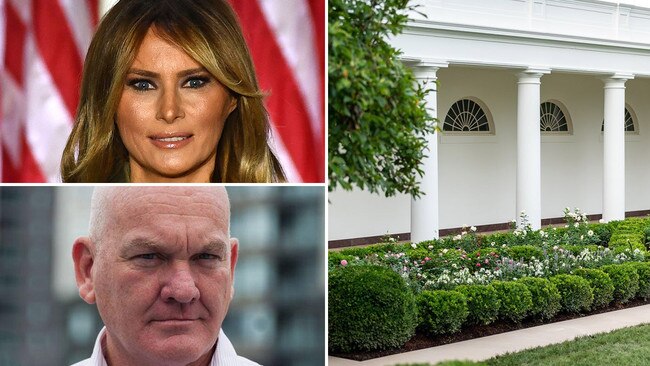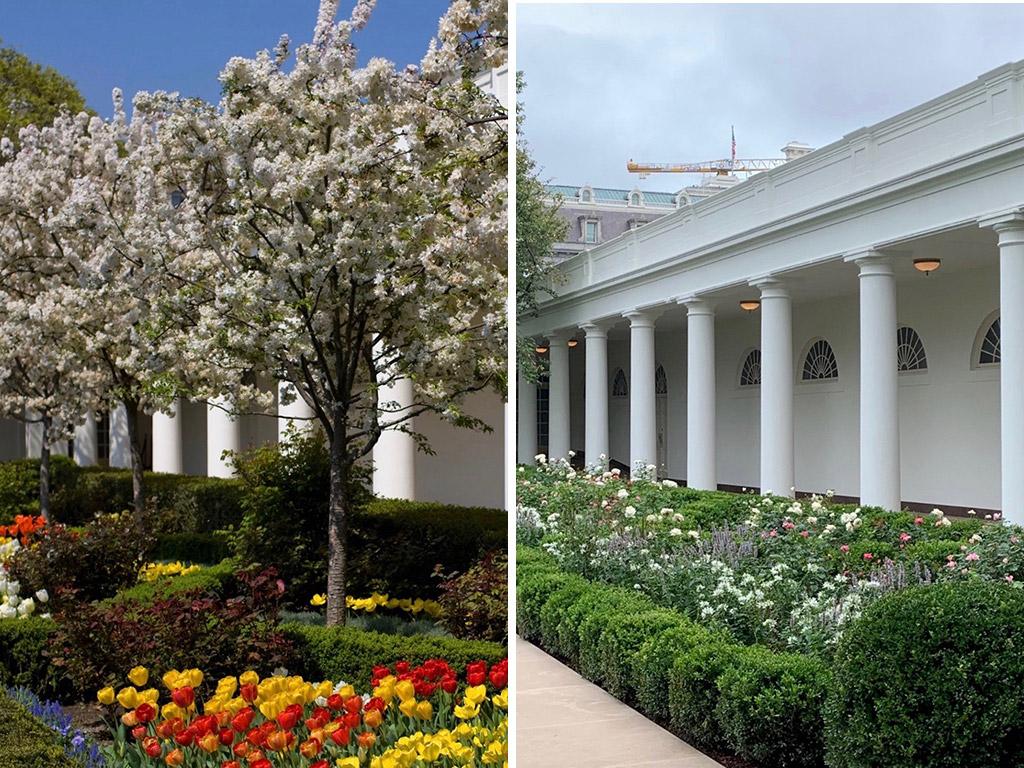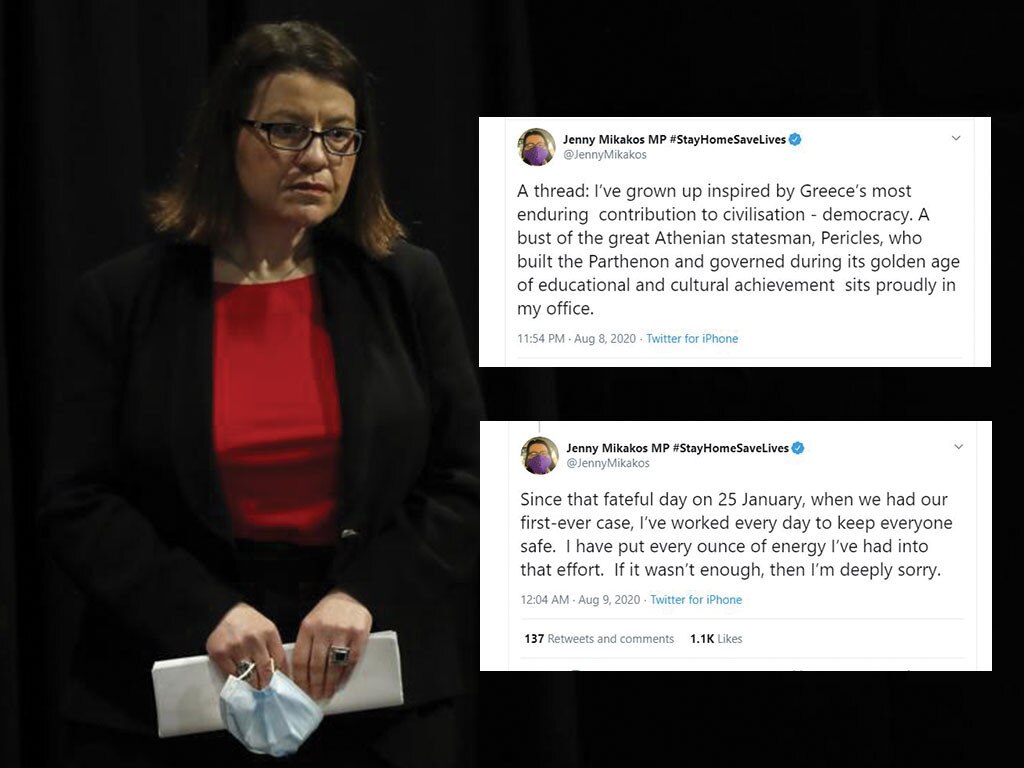
Excited to honor history & celebrate the future in our beautiful @WhiteHouse Rose Garden this evening. Thank you to all who helped renew this iconic & truly gorgeous space. pic.twitter.com/ggiqLkdGbw
— Melania Trump (@FLOTUS) August 22, 2020
“This once colourful and exuberant and shady space has been replaced by a far more formal and severe planting,” said Green. “We wonder what that might say about – perhaps this is to elevate it beyond its significance, perhaps not – the direction of American democracy.” It is a tad ironical that Green used the royal ‘we’ when decrying the president’s supposedly monarchist ambitions, but I digress.
You might be wondering how the garden in question was altered to give it authoritarian overtones – the installation of a moat, the planting of Honey Locust and Prickly Ash trees along with tropical Manchineels, the toxic sap of which causes the skin to blister, perhaps? No, the most significant changes were merely the removal of a dozen crabapple trees, the replacement of the previous roses with pastels, the installation of a few boxwoods, and the addition of a limestone walking path bordering the central lawn. Oh, and there is the improved drainage as well as providing better access for people with disabilities. Terrible I know.
The changes were all too much for Green, who spoke of a garden which had provided a “shady, friendly sort of space” when the Obamas had occupied the White House. All that had apparently changed under the Trumps. “The trees have gone as well,” lamented Green. “I mean this is quite a bold statement to pull out trees that date back to the Kennedys”.
Likewise, it was quite bold of Green to make a statement that was, well, balderdash. The original crabapple trees were planted during John F. Kennedy’s presidency; however, as confirmed by Marta McDowell, author of “All the Presidents’ Gardens,” they have been replaced three times since. As for the current crabapple trees, they will be planted elsewhere on the White House grounds given they were overshadowing the roses.
But Green was not alone in seeing this as a case of foliage fascism. His guest, Amir Alexander, a UCLA academic, saw parallels in the garden redesign with – wait for it – that of the Sun King. “As it is now it is entirely open, every corner is visible from the Oval Office … all the parterres, all the lines of bushes, the lines of flowers and now also that framework, those aligns of the pathway that line along the sides of the garden, that all of them converge and all of them lean to the West Wing and the Oval Office,” he said. “The language and the implications are directly derived from that style that was invented in Versailles.”
Responding to Alexander’s assertion that the White House now featured a “power garden”, Green was eager to attribute messianic traits to the President. ”What does that kind of garden say about its owner; what does it say about the powerful personage that in its way represents,” he asked.
In response Alexander claimed that previous occupants of the White House were careful to ensure the design of the gardens reflected the appropriate checks on executive power. “Those elements of power, projecting power in that garden, were always tempered by other elements and made sure that even the great power of a President is never compared to the absolute power of a monarch like Louis XIV,” he said. Sacré bleu.
Let’s put this in perspective. The Gardens of Versailles comprise 800 hectares. The White House Rose Gardens is less than one hectare. The former took 40 years to construct, the latter was transformed over three weeks and funding was met by private donations. Do we need any more comparisons to refute these ridiculous analogies?
Noting the White House announcement in July that the revamp of the gardens would be modelled on that carried out during the Kennedy presidency, the Guardian was in full Jacobin mode. “The First Lady’s attempts to restore the past seem to be working, albeit not in the way she may have intended,” sneered Arwa Mahdawi, adding that ‘Marie Antoinette’ had started trending on Twitter after the renovations were announced. “While Melania T may be attempting to channel Jackie O, it looks as though she can’t help giving off strong Marie A vibes.”
“The geometry of the revised garden, the equality of its pavers, belies the inequality of our time; seemingly mocking the chaos wrought by the Trump administration,” wrote Wendy R. Sherman in USA Today. Author and former New York Times senior reporter Kurt Eichenwald, who has numerous times accused the President and his supporters of racism and xenophobia, angrily tweeted the First Lady was a “foreigner” who was trying to “wreck our history”.
It is a depressing reminder of how far activist journalists will go to construct a narrative, irrespective of its implausibility. Perhaps we should have a competition for the silliest appraisal of presidential policy based on a horticultural perspective. I will begin with an edition of The Queenslander dated April 15, 1905, which notes: “A window opened into the White House rear gardens, and gave an excellent and uninterrupted view of the lofty Washington monument about 300 paces distant.” This was during the era of Theodore Roosevelt. Had political commentators observed more closely at the commencement of this presidency, they would have correctly inferred from this seemingly innocuous construction of the gardens that he favoured the Isthmus of Panama as the site for a canal and would support secessionist movements in Colombia in order to realise it.
Then there was this from The Advertiser edition of April 19, 1930, noting the reminisces of the White House’s official gardener, Charles Henlock: “In his long connection with the White House he has seen the conservatories grow from a small glassed-in section of the mansion to thirty greenhouses, twelve of which are wholly devoted to flowers”. My conclusion is that this was a sign of President Herbert Hoover’s inability to respond effectively in the early stages to what became the Great Depression. Also, this surfeit of flowers is indicative of GOP insouciance.
And let’s not forget that on 11 June 1973 the Papua New Guinea Post-Courier reported that President Richard Nixon was photographed strolling in the White House Rose Garden. Two days later Watergate prosecutors found a White House memo describing plans to break into the office of Pentagon Papers defendant Daniel Ellsberg’s psychiatrist. Coincidence? I think not.
Do not laugh, for there are academics in western universities who would consider these examples worthy of a PhD thesis. As for the ABC, the fact Green views the relocation of a dozen crabapple trees as ominous gives you an indication as to how balanced the national broadcaster will be in its coverage of the upcoming presidential election. The White House Rose Garden is to Versailles what ABC is to Australia, you might quip.
But in fairness to Green, the triggering of journalists over goings-on in the White House grounds over absolutely nothing goes back a long way. Writing for Brisbane’s Sunday Mail on April 16, 1950, British journalist Don Iddon told of the alarm and terror he experienced in the US capital.
“When I went for a walk towards the White House, I was startled by what I took to be a burst of machinegun fire,” he wrote. “I thought thugs had moved in with sawn-off shotguns and were wiping out Cabinet members along Pennsylvania Avenue. However, it turned out that the noise came from the pneumatic drills of workmen in the White House gardens.” Iddon survived his scare and went on to live and write for another 29 years. Who knows, maybe there is hope for Green yet.
More Coverage
I think the new Rose Garden is beautiful. Understated elegance and a classy look. It will be amazing once it grows in a bit too. People need to calm down.
— Megyn Kelly (@megynkelly) August 23, 2020







If you listened to ABC Radio National’s Blueprint last Saturday, you would have learned of an alarming development at the highest level of American government. In short, President Donald Trump intends replacing the republic with an absolutist monarchy. How do we know this? Well, according to host Jonathan Green, it is to be found in First Lady Melania Trump’s recent revamping of the White House Rose Garden.